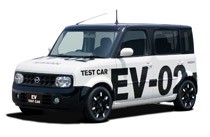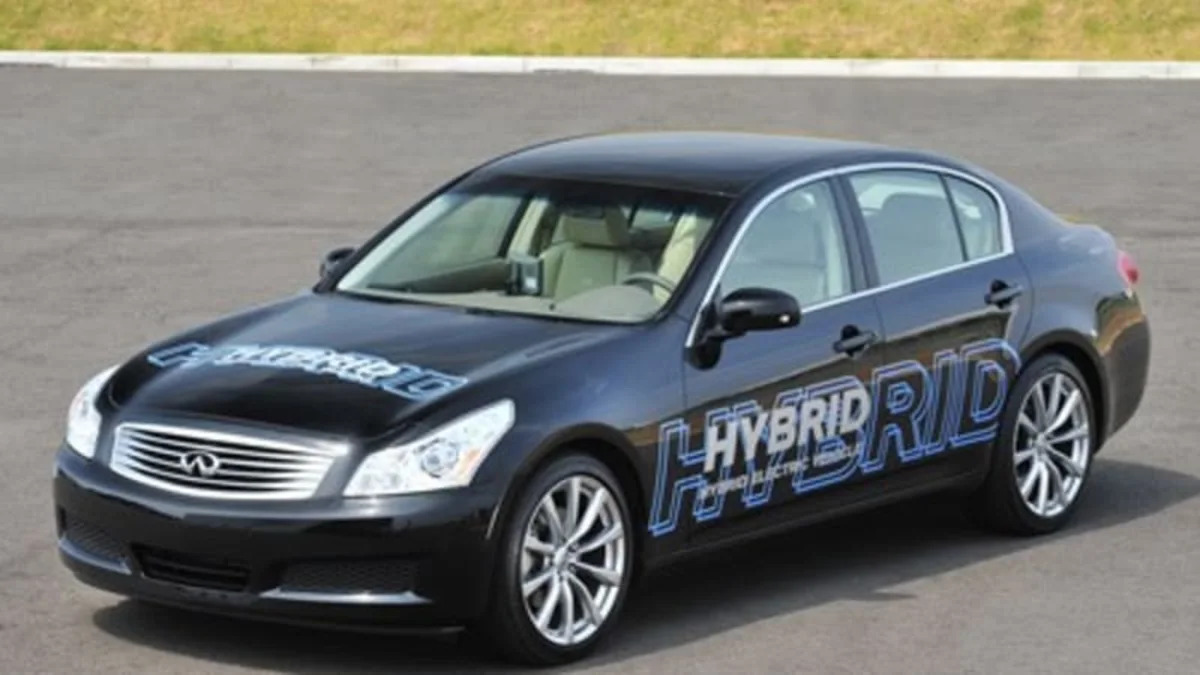Click above for high-res gallery of Nissan's new green cars
Nissan has been selling a hybrid version of its Altima sedan in select U.S. states for the last two years that uses a licensed version of Toyota's Hybrid Synergy Drive. At the same time it's been working on its own hybrid and all-electric powertrains, and yesterday it unveiled two prototypes that show us exactly what it will be replacing those Prius parts with.
The first is a new hybrid system that will debut on a rear-wheel-drive Infiniti model, most likely the G. It employs a parallel hybrid system with one electric motor and two clutches that allows the gas engine and electric motor to power the vehicle at the same time. Nothing fancy there, but Nissan's new hybrid will be one of the first to use lithium-ion rather than nickel-metal hydride batteries. The smaller, more efficient batteries were developed by a joint-venture company between Nissan and NEC called Automotive Energy Supply Corporation (AESC).
 Meanwhile, those same li-ion batteries are also being tested in an all-electric vehicle. Though currently installed in a JDM Nissan Cube, the system will eventually be put in all-new model with unique styling and be on the Japanese market by 2010 and sold globally by 2012. It uses a new 80kW motor and inverter and packs all the batteries beneath its floor.
Meanwhile, those same li-ion batteries are also being tested in an all-electric vehicle. Though currently installed in a JDM Nissan Cube, the system will eventually be put in all-new model with unique styling and be on the Japanese market by 2010 and sold globally by 2012. It uses a new 80kW motor and inverter and packs all the batteries beneath its floor.
Very cool stuff, Nissan. Just leave the vinyl graphics at home next time.
Nissan has been selling a hybrid version of its Altima sedan in select U.S. states for the last two years that uses a licensed version of Toyota's Hybrid Synergy Drive. At the same time it's been working on its own hybrid and all-electric powertrains, and yesterday it unveiled two prototypes that show us exactly what it will be replacing those Prius parts with.
The first is a new hybrid system that will debut on a rear-wheel-drive Infiniti model, most likely the G. It employs a parallel hybrid system with one electric motor and two clutches that allows the gas engine and electric motor to power the vehicle at the same time. Nothing fancy there, but Nissan's new hybrid will be one of the first to use lithium-ion rather than nickel-metal hydride batteries. The smaller, more efficient batteries were developed by a joint-venture company between Nissan and NEC called Automotive Energy Supply Corporation (AESC).
 Meanwhile, those same li-ion batteries are also being tested in an all-electric vehicle. Though currently installed in a JDM Nissan Cube, the system will eventually be put in all-new model with unique styling and be on the Japanese market by 2010 and sold globally by 2012. It uses a new 80kW motor and inverter and packs all the batteries beneath its floor.
Meanwhile, those same li-ion batteries are also being tested in an all-electric vehicle. Though currently installed in a JDM Nissan Cube, the system will eventually be put in all-new model with unique styling and be on the Japanese market by 2010 and sold globally by 2012. It uses a new 80kW motor and inverter and packs all the batteries beneath its floor.
Very cool stuff, Nissan. Just leave the vinyl graphics at home next time.
[Source: Nissan]
PRESS RELEASE
NISSAN PREVIEWS NEXT GENERATION ENVIRONMENTAL VEHICLES
- All-electric and original hybrid electric prototypes unveiled –
TOKYO (August 6, 2008) - Nissan Motor Co., Ltd today unveiled all-electric and original hybrid electric prototype vehicles, both powered by advanced lithium-ion batteries. Under the NISSAN GT 2012 business plan, the company has committed to zero-emission vehicle leadership, and has announced plans to introduce an all-electric vehicle in 2010 and mass market globally in 2012.
Electric Vehicle (EV)
Powered by advanced lithium-ion batteries, the EV prototype is part of Nissan's substantial research and development programme on zero emission vehicles. This latest generation vehicle features a front-wheel drive layout and uses a newly developed 80kW motor and inverter. The advanced laminated compact lithium-ion batteries are installed under the floor, without sacrificing either cabin or cargo space.
The production vehicle to be introduced in 2010 will have a unique bodystyle and is not based on any existing Nissan model.
Hybrid Electric Vehicle (HEV)
The Nissan original HEV delivers two breakthrough technologies – a high-performance rear-wheel drive hybrid system and parallel-powertrain hybrid system. The hybrid employs Nissan's own originally developed hybrid technology and its first rear-wheel drive hybrid powertrain.
The parallel-powertrain system comprises an energy-optimising system with two clutches, where one motor is directly connected to an engine and transmission via two separate clutches. Under changing driving conditions, the motor switches between the two clutches to optimise and conserve energy utilisation as well as improve fuel-efficiency.
The parallel-powertrain hybrid system eliminates the need for conventional torque converters, contributing to higher responsiveness and linear acceleration for improved driving feel.
The dynamic characteristics of the clutches are as follows:
- Idle-stop: The battery is used to power the motor to save on fuel.
- Regular driving: The engine is used to power the motor as well as regenerate the battery.
- Acceleration: Both the engine and battery (power assist) is used to power the motor to achieve smooth acceleration.
- Deceleration: Energy from braking is conserved and re-routed back to regenerate the battery.
- Lithium-ion Battery
Nissan has long experience in electric-powered vehicle development, commencing from the first EV "Tama Electric Vehicle" back in 1947. The company introduced the world's first application of lithium-ion batteries to the Prarie Joy EV in 1996, followed by the ultra-compact electric vehicle, Hypermini, released in 2000. Nissan also introduced its first original hybrid vehicle Tino Hybrid back in 1999 in Japan. In 2006, the Altima Hybrid was introduced in North America using licensed technology.
Under the Nissan Green Program 2010 environmental plan, the company aims to develop new technologies, products and services that can lead to real-world reductions in vehicle CO2 emissions, cleaner emissions, and recycling of resources. Nissan continues to invest substantially in a wide range of technologies including CVT (Continuously Variable Transmission), VVEL (Variable Valve Event and Lift), clean diesels, biofuels and fuel cell vehicles.


Sign in to post
Please sign in to leave a comment.
Continue